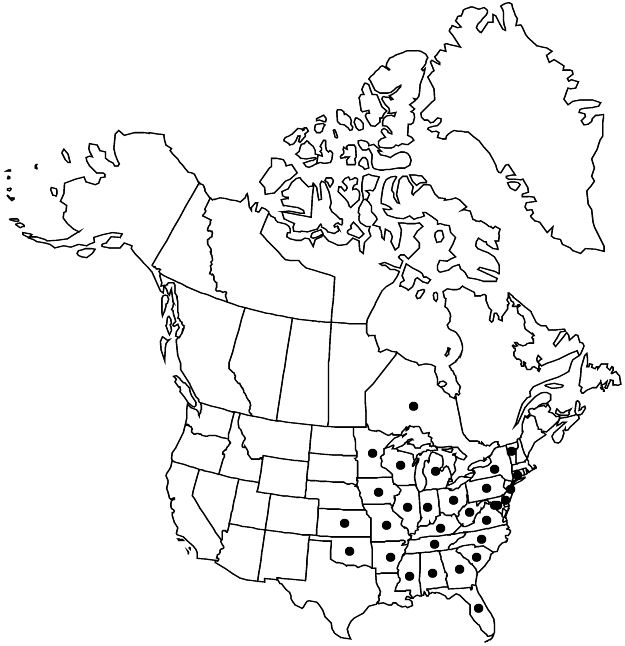Difference between revisions of "Hybanthus concolor"
Syst. Veg. 1: 805. 1824.
FNA>Volume Importer |
imported>Volume Importer |
||
| (5 intermediate revisions by 2 users not shown) | |||
| Line 12: | Line 12: | ||
|label=Endemic | |label=Endemic | ||
}} | }} | ||
| − | |basionyms={{Treatment/ID/ | + | |basionyms={{Treatment/ID/Basionym |
|name=Viola concolor | |name=Viola concolor | ||
|authority=T. F. Forster | |authority=T. F. Forster | ||
| + | |rank=species | ||
| + | |publication_title=Trans. Linn. Soc. | ||
| + | |publication_place=6: 309, plate 28. 1802 | ||
}} | }} | ||
|synonyms={{Treatment/ID/Synonym | |synonyms={{Treatment/ID/Synonym | ||
|name=Cubelium concolor | |name=Cubelium concolor | ||
|authority=(T. F. Forster) Rafinesque ex Britton & A. Brown | |authority=(T. F. Forster) Rafinesque ex Britton & A. Brown | ||
| + | |rank=species | ||
}} | }} | ||
|hierarchy=Violaceae;Hybanthus;Hybanthus concolor | |hierarchy=Violaceae;Hybanthus;Hybanthus concolor | ||
| Line 43: | Line 47: | ||
-->{{#Taxon: | -->{{#Taxon: | ||
name=Hybanthus concolor | name=Hybanthus concolor | ||
| − | |||
|authority=(T. F. Forster) Sprengel | |authority=(T. F. Forster) Sprengel | ||
|rank=species | |rank=species | ||
| Line 58: | Line 61: | ||
|publication year=1824 | |publication year=1824 | ||
|special status=Endemic | |special status=Endemic | ||
| − | |source xml=https:// | + | |source xml=https://bitbucket.org/aafc-mbb/fna-data-curation/src/2e0870ddd59836b60bcf96646a41e87ea5a5943a/coarse_grained_fna_xml/V6/V6_189.xml |
|genus=Hybanthus | |genus=Hybanthus | ||
|species=Hybanthus concolor | |species=Hybanthus concolor | ||
Latest revision as of 22:19, 5 November 2020
Plants subshrubs, perennial, 30–80(–100) cm, from thick rhizome with fibrous roots. Stems 1 or several-clustered, erect, simple, usually hairy, sometimes glabrous or subglabrous. Leaves: proximal and distal alternate, petiolate, distalmost sessile or nearly so; stipules narrowly elliptic to linear or lanceolate, (0.5–)4–25(–30) mm, sparsely hirsute; petiole 6–20 mm; blade elliptic or oblanceolate, 6.5–17 × 1.5–6 cm, base attenuate or acuminate, margins entire or sparsely serrate, ciliate or eciliate, apex acute to long-acuminate, surfaces usually strigose and/or sericeous, sometimes glabrous, trichomes scattered throughout or concentrated along outer margins, veins, or petiole. Inflorescences 1–3-flowered; peduncle recurved at anthesis, becoming erect, 5–23 mm, pilose; bracteoles present. Flowers: sepals often spreading from corolla, linear to linear-lanceolate, margins ciliate or eciliate, apex acute; petals: upper and laterals greenish white, oblong, 3.5–5 mm, margins usually with scattered cilia, apex usually truncate and recurved, glabrous; lowest greenish white, 4–5.5 mm, claw 0–1 × 3–4 mm, usually longer and wider than others, distal limb oblong, ± flat to convex, 3–5 mm wide, apex retuse, sometimes rounded, usually glabrous; cleistogamous flowers, when present, from axils of distal leaves. Capsules oblong to ellipsoid, (8–)15–20 mm. Seeds 6–9, white to cream, globose to broadly ovoid, (3–)4–7 mm. 2n = 48.
Phenology: Flowering Apr–early Jul.
Habitat: Rich, limestone soil and talus in woodlands, slopes, ravines
Elevation: 100–1000 m
Distribution

Ont., Ala., Ark., Conn., Del., D.C., Fla., Ga., Ill., Ind., Iowa, Kans., Ky., Md., Mich., Minn., Miss., Mo., N.J., N.Y., N.C., Ohio, Okla., Pa., S.C., Tenn., Vt., Va., W.Va., Wis.
Discussion
R. E. Brooks and R. L. McGregor (1986) reported that no cleistogamous flowers have been seen on plants of Hybanthus concolor collected in the Great Plains. It is believed extinct in Connecticut and is listed as endangered in Florida.
Selected References
None.